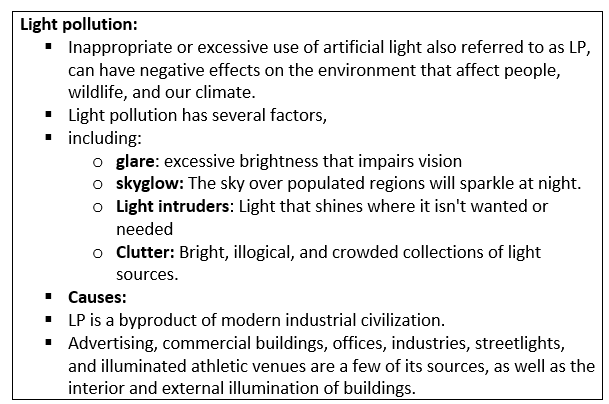28 Jan Skyglow: Light pollution
Skyglow: Light pollution
This article covers “Daily current affairs for UPSC “and the topic is” Skyglow” which is in the news, it covers the “Environment and ecology” In GS-3, the following content has relevance for UPSC.
For Prelims: About Skyglow, light pollution,
For Mains: GS-3, Implications of Skyglow
Why in the news:
- The brightness of Skyglow has recently been determined to have grown due to artificial lighting by 9.2-10% annually between 2011 and 2022, with severe ecological, health, and cultural ramifications.
- A global database that contained more than 51,000 entries contributed by citizen scientists and listed the dimmest star that may be seen from a specific place has been examined by researchers.
About Skyglow
- The Skyglow, which blankets the night sky above and around towns and can obscure all but the brightest stars, is a constant sheet of light.
- It is caused by the brightening of the night sky over populated areas brought on by streetlights, security floodlights, and outdoor decorative lights.
- The Nocturnal (active at night) are blinded by this light, which also floods into the heavens and distorts their course.
- One element of light pollution is “skyglow.”
Skyglow scenario entails
Global
- Over Europe, the Skyglow had brightened by around 6.5%, over North America by about 10.4%, and over the rest of the planet by about 7.7%.
- The result is noteworthy since it contradicts satellite-based statistics that suggested the rate of rise had been roughly 2% annually.
- The mismatch is most likely due to the satellites’ inability to detect blue LED light and analyze light that is emitted perpendicular to the ground.
India
- According to a 2016 study, 19.5% of Indians live in a country with the least amount of skyglow among the G20 nations, which would at the very least prevent viewing of the Milky Way galaxy and, at the very worst, prevent “dark adaptation for human eyes.”
- One of the results is the stimulation of cone cells in the human eye, which is only feasible in well-lit environments.
- According to a 2017 study, between 2012 and 2016, India’s illuminated area expanded by 1.07 to 1.09%, and the average radiance of “stably lit areas” — i.e., places that aren’t affected by wildfires — increased by 1.05 to 1.07%.
- It affects all elements of insect life and prolongs the hunting season for bug predators, according to a study from 2020.
- Using artificial light at night can hinder the body’s ability to produce melatonin, a key hormone that influences sleep, mood, and cognition, according to a study published in 2020.
Impact of light pollution
Energy and financial waste:
- It is inefficient to have lighting that shines when and where it is not needed, or that emits too much light. Energy waste has severe economic and environmental repercussions.
Ecosystem disruption and wildlife extinction
- Plants and animals rely on the earth’s daily cycle of light and dark to guide life-sustaining behaviors including reproduction, nutrition, sleep, and protection from predators.
- According to scientific data, nighttime artificial light has harmful and fatal impacts on a variety of animals, including amphibians, birds, mammals, insects, and plants.
- Ex: Sea turtles are discouraged from nesting on beaches that are lit. Skyglow prevents trees from detecting seasonal changes.
- When clownfish eggs are exposed to artificial light at night, they do not hatch, killing the young.
Negative Effects on Human Health of Light Pollution
- Humans have a circadian rhythm, or biological clock, that is dictated by the day-night cycle, just like the majority of life on Earth. That cycle can be broken at night by artificial light.
- A small 2009 assessment found that night shift workers had a 40% higher risk of breast cancer due to circadian disturbance, which can be brought on by changed melatonin levels.
- The destruction of the night sky works as a type of continuous cultural and ecological genocide by erasing Indigenous people’s connection to the stars.

Light pollution
Way ahead
- Over 130 “International Dark Sky Places,” where artificial lighting has been modified to lessen skyglow and light trespass, have been certified by the International Dark-Skies Association. However, the majority are in northern hemisphere developed nations.
- The chance to engage in lighting solutions before animals there are substantially harmed is presented by the fact that less developed areas are frequently both species-rich and currently less light-polluted.
- The scientists advise using light sources that cast light at an angle below the horizon, capping their emissions, and adjusting their output by the overall brightness of the area being illuminated.
- Where lights cannot be turned off, they can be shaded to prevent light pollution of the surroundings and the sky.
Source:
Daily Current Affairs for UPSC
Gain knowledge of the diverse aspects of the Global world by reading about daily current affairs. The broadened knowledge of the national and international world helps to pass the UPSC examination. Plutus IAS collaborates with the aspirants by providing the best daily current affairs for the UPSC examination. So, every UPSC aspirant should scrutinize Current Affairs regularly. Also, read monthly and weekly current affairs today for IAS exam preparation.



No Comments